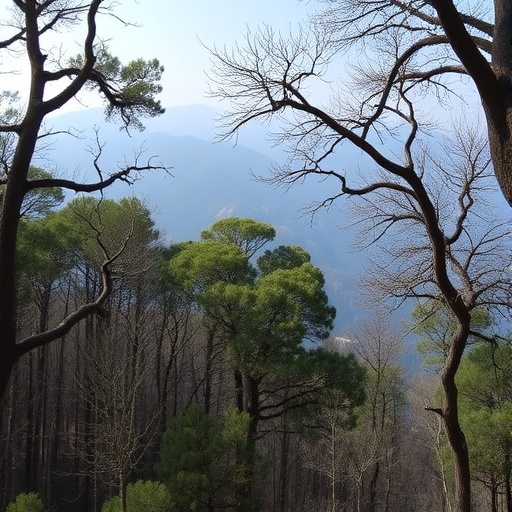In a groundbreaking study assessing the intricate relationship between elevation gradients, aspect, and forest structure, researchers have shed new light on the ecology of the evergreen oak forest belt in the Western Himalayas. The paper, authored by Rawal et al., provides a detailed investigation into the patterns of species regeneration in this vital ecosystem, revealing critical insights that could have significant implications for forest management and conservation efforts in mountainous regions.
The research was conducted across various elevations, encompassing a range of microclimates and soil types, which are known to influence forest composition and regeneration dynamics. By systematically analyzing tree species distribution and their growth patterns, the team sought to understand how these variables interact to shape the forest structure. This study is particularly pertinent given the ongoing pressures of climate change and human encroachment in the region, which pose threats to biodiversity and ecosystem health.
One of the highlight findings of the study is the pronounced effect of elevation on both tree composition and regeneration capability. The researchers noted distinct variations in species richness and abundance as altitude increased. This trend underscores the adaptability of certain species to specific altitudinal zones, thereby illuminating the ecological niche each species occupies. Such findings emphasize the importance of altitude as a fundamental environmental gradient influencing forest dynamics.
Moreover, the aspect of slopes—whether they face north, south, east, or west—also emerged as a critical factor in determining species distribution and growth rates. North-facing slopes, characterized by cooler, moister conditions, support a different assemblage of flora compared to the hotter, drier, and more nutrient-poor south-facing slopes. This differential aspect effect is vital for forest regeneration strategies and could inform future reforestation projects, ensuring that appropriate species are selected based on their specific habitat preferences.
The methodology utilized in this research is worth noting, as it exemplifies a robust approach combining field surveys with advanced statistical modeling. The researchers employed a variety of sampling techniques to gather data, including plot-based assessments and remote sensing technologies, which facilitated a comprehensive understanding of spatial patterns. This methodological rigor enhances the reliability of the findings, making them a valuable contribution to the field of forest ecology.
As the authors delve deeper, they uncover the complex interplay of biotic and abiotic factors in shaping forest dynamics. Soil characteristics, particularly pH and nutrient availability, were found to significantly influence species growth and regeneration. The insights provided by this research could help inform soil management practices, ensuring that conditions are optimized for the successful establishment of tree species crucial for ecosystem stability.
Another significant aspect discussed in the study is the ongoing threat posed by invasive species in the Western Himalayas. The authors present evidence of how these non-native species exploit the altered conditions created by climate change and land use changes. By understanding the mechanisms behind invasive species success, conservationists and land managers can devise strategies to mitigate their impact, safeguarding native biodiversity.
The research team also emphasizes the need for an integrative approach to forest management, one that takes into account the ecological intricacies and dynamics at play within these ecosystems. A purely anthropocentric view may lead to unsustainable practices that disrupt delicate ecological balances, threatening both the forest and its myriad inhabitants. Thus, the study serves as a call to action for policymakers and stakeholders to embrace strategies that harmonize ecological health with human interests.
Importantly, the findings of this research have broader implications beyond the immediate context of the Western Himalayas. As the world grapples with the repercussions of climate change, understanding forest resilience and adaptability becomes crucial for global conservation efforts. The lessons gleaned from this study may have applications in similar ecosystems worldwide, facilitating broader discussions on biodiversity conservation and sustainable forest management.
It is increasingly clear that forests are not merely collections of trees but dynamic systems characterized by complex interactions among species, environmental factors, and human influences. The layered sophistication of these ecosystems demands a nuanced approach to research and conservation. Future studies will need to further explore the cascading effects of environmental change on forest health, particularly in biodiversity hotspots like the Himalayas.
In closing, this research contributes vital knowledge to our understanding of forest dynamics in the Western Himalayas, highlighting the significance of elevation and aspect in species regeneration and structure. As our global environment continues to shift due to anthropogenic pressures, studies like this are essential, offering critical insights that can guide conservation efforts and promote sustainable practices in forest management.
In summary, Rawal et al.’s exploration of the evergreen oak forest belt serves as a timely reminder of the fragility of these ecosystems and the urgent need for informed stewardship. It reinforces the importance of comprehensive ecological studies in fostering a deeper understanding of our natural world, navigating the complexities of conservation in the face of unprecedented change.
Subject of Research: Ecological patterns of forest structure and species regeneration in the evergreen oak forests of the Western Himalayas.
Article Title: Pattern of forest structure and species regeneration along with elevation gradients and aspects in evergreen oak forest belt of the Western Himalaya.
Article References:
Rawal, R., Dasila, K., Kishor, K. et al. Pattern of forest structure and species regeneration along with elevation gradients and aspects in evergreen oak forest belt of the Western himalaya.
Discov. Plants 2, 297 (2025). https://doi.org/10.1007/s44372-025-00381-3
Image Credits: AI Generated
DOI: 10.1007/s44372-025-00381-3
Keywords: Forest structure, species regeneration, elevation gradients, evergreen oak forest, Western Himalayas, conservation, biodiversity, climate change.




